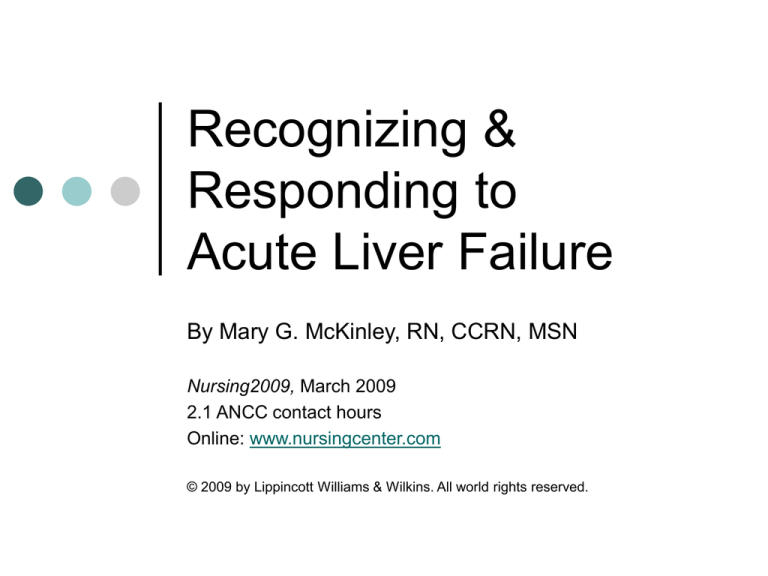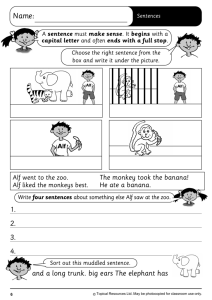
Recognizing &
Responding to
Acute Liver Failure
By Mary G. McKinley, RN, CCRN, MSN
Nursing2009, March 2009
2.1 ANCC contact hours
Online: www.nursingcenter.com
© 2009 by Lippincott Williams & Wilkins. All world rights reserved.
Acute liver failure (ALF)
Medical emergency
Affects 2,000 people per year in the U.S.
40% mortality rate
Rare condition that often strikes young
people
The liver wears many hats
Digestive role
- Produces bile salts for fat digestion
- Processes and stores fats, carbohydrates,
and proteins
- Processes and stores vitamins and
minerals
- Synthesizes cholesterol
- Produces triglycerides
The liver wears many hats
Endocrine role
- Regulates the metabolism of
carbohydrates, fats, and proteins
- Metabolizes hormones such as
mineralocorticoids, glucocorticoids, and sex
hormones
The liver wears many hats
Excretory role
- Excretes bile
- Excretes cholesterol
- Converts ammonia to urea
- Detoxifies drugs, hormones, and other
foreign substances
The liver wears many hats
Hematologic role
- Stores blood
- Synthesizes all but two clotting factors
- Synthesizes bilirubin
Cross section of liver lobule
Defining ALF
Evidence of coagulation abnormalities
Usually an INR of greater than 1.5
Mental alteration (encephalopathy)
All in a patient without prior cirrhosis and
illness less than 26 weeks
What ALF is not
According to American Association for the
Study of Liver Diseases (AASLD):
- ALF is the preferred term
- not fulminant hepatic failure
- not fulminant hepatitis or necrosis
AASLD recommends against using terms
related to duration of illness such as
hyperacute, acute, subacute because when
used alone, terms don’t offer clues to
patient’s progress
Common causes
Most commonly caused by toxic agents and
infectious disorders
Acetaminophen overdose is the most
common cause in U.S. and Europe
Toxic doses are highly variable; doses of
150mg/kg or 7 g have been found to be
toxic
Acetaminophen toxicity
Acetaminophen is an active ingredient in
many over-the-counter remedies, such as
cold and flu remedies
This can lead to unintentional overdose
Other triggers
The following conditions are vulnerable to
acetaminophen toxicity at lower doses:
- Chronic alcohol abuse
- Preexisting liver disease
- Malnutrition/fasting
ALF: Many causes
Infections
- Hepatitis A and B viruses
- Herpes simplex virus
- Varicella-zoster virus
- Cytomegalovirus
ALF: Many causes
Toxins
- Drugs: acetaminophen, halothane,
methyldopa, isoniazid, chronic alcohol
abuse, ecstasy
- Other toxins: sea anemone, mushroom
poisoning, carbon tetrachloride
ALF: Many causes
Injury
- Ischemia after cardiac arrest, shock,
severe heart failure
ALF: Many causes
Parenchymal disease
- Malignant infliltration: lymphoma,
melanoma, breast cancer
- Primary liver tumor
- Cirrhosis
- Wilson’s disease
ALF: Many causes
Other processes
- Vascular abnormalities such as hepatic
veno-occlusive disease (Budd-Chiari
syndrome)
- Fatty liver of pregnancy
- Primary graft nonfunction following liver
transplant
3 pathophysiologic
mechanisms of ALF
Rapidly developing hepatocellular
dysfunction
Blood flow through liver is disrupted
Cerebral edema and intracranial
hypertension
Hepatocellular dysfunction
Interrupts elimination of bilirubin
Interrupts synthesis of protein, glucose, and
coagulation factors
Due to lack of protein synthesis, capillary
oncotic pressure decreases, causing fluid
shifts from intravascular to
interstitial/intraperitoneal spaces
Hepatocellular dysfunction
Hormones such as aldosterone are not
inactivated; causes high aldosterone blood
levels
In turn, causes kidneys to retain sodium and
water and excrete potassium
End result is further fluid and electrolyte
imbalances
Disrupted blood flow
through the liver
Resistance by the liver of blood flow
Causes portal hypertension
Portal hypertension causes congestion and
engorgement of venous circulation,
especially in GI and renal systems
Engorgement can lead to: esophageal
varices, bleeding, ascites due to vascular
leak into peritoneal cavity
Cerebral edema and
intracranial hypertension
Considered most serious complication of
ALF
Cerebral edema caused by brain cell
swelling and disruption of blood-brain
barrier
Cerebral edema leads to cerebral
hypertension, which decreases perfusion;
can lead to irreversible neurologic damage
Cerebral edema
Other factors that may contribute to
encephalopathy:
- Hypoglycemia
- Sepsis
- Hypoxemia
- Seizures
Signs & symptoms of ALF
Weakness, fatigue, or malaise from
alterations in metabolism of fats, protein,
and glucose
Anorexia or poor nutritional status due to
poor GI blood flow
Bleeding/bruising from altered coagulation
factors
Signs & symptoms of ALF
Jaundice from decreased bilirubin uptake
and conjugation
Encephalopathy - characterized by CNS
disturbances ranging from lack of attention
to confusion and coma
Hypotension and fluid/electrolyte imbalance
due to decrease of plasma proteins in the
liver
Assessing a cause
Most important to identify and treat
underlying cause:
- acetaminophen toxicity can be treated with
N-acetylcysteine
-herpes virus may respond to acyclovir
Liver transplantation considered early in
therapy as patients with ALF deteriorate
rapidly with serious complications
Considering transplant
Before deciding on transplant, healthcare
team must balance likelihood of
spontaneous recovery with risks associated
with transplantation
Significant criteria for transplant: disease
etiology, age of patient, jaundice to coma
interval, serum bilirubin level, prothrombin
time, arterial pH, serum creatinine
Considering transplant
Criteria are readily available; could be used
to expedite transfer to a center and early
listing for transplant
Living donor transplantation a possibility
made necessary by scarcity of organs from
deceased donors
Considering transplant
Before liver transplantation was available,
as few as 15% of patients with ALF survived
Refinement of transplant surgery,
immunosuppressive agents, and
comprehensive care has increased survival
rate posttransplant to 65% or even 80%
Managing patient care
Number one priority: Maintain ABCs (airway,
breathing, circulation)
Elevate head of bed to facilitate breathing
and prevent aspiration
May need to administer oxygen and/or
prepare for mechanical ventilation
Managing patient care
Antiepileptic drugs may be needed to
prevent or treat seizures
Ongoing care will depend on patient’s
condition
Weakness, fatigue, and malaise: Encourage
rest with pacing of activities while
preventing complications of immobility
Nursing care
Pneumonia prevention: Encourage deep
breathing and coughing, and ambulation
- Follow infection control guidelines
- Use of incentive spirometry
Prevent venous thromboembolism - initiate
prophylaxis
Nursing care
Prevent pressure ulcers by identifying
patient at risk and implementing strategies
- Skin care
- Repositioning
- Nutrition/hydration
Nursing care
Anorexia/poor nutritional status
- Measure and record daily weights,
abdominal girth, intake and output
- Patient should have adequate amounts
of protein and vitamins
- May need to initiate enteral/parenteral
feedings early in the course of treatment
Nutritional supplementation
HepatAmine - hypertonic solution contains
crystalline amino acids
- Administered I.V.
- Provides protein, vitamins, and minerals
(such as potassium)
Vivonex Plus - enteral formula, 100% free
amino acids given orally or NG
Nursing care
Coagulation problems
- Check stool and urine for blood
- Check vital signs
- Assess lab values (CBC, INR)
Prevent GI bleeding
- Administer histamine receptor agonists or
proton pump inhibitor as ordered
- Insert NG, check gastric pH
Minimizing injury due
to bleeding
Assess fall risk and institute precautions
Institute seizure precautions
Instruct on use of safety razor and softbristle toothbrush
Administer stool softeners as prescribed
Apply pressure to all puncture sites until
hemostasis achieved
Nursing care regarding
esophageal varices
Esophagogastroduodenoscopy with
sclerotherapy may be considered
- Sclerosant such as sodium morrhuate is
injected into the varix
- Procedure has 90% success rate
Pharmacologic approaches
to esophageal varices
Ocreotide and vasopressin given with
nitroglycerin
Both medications reduce blood flow
Nitroglycerin reduces detrimental effects of
vasopressin while preserving its beneficial
effects
Sengstaken-Blakemore tube
Temporary, emergency, lifesaving measure
Others are Minnesota and Linton-Nachlas
Tubes provide tamponade at bleeding site
No longer the treatment of choice due to
respiratory compromise and/or clot
disruption following removal
Nursing care of skin integrity
Pruritus and edema associated with liver
failure
Inspect skin daily
Keep fingernails short
Avoid alcohol-based skin products
Nursing care of skin integrity
Use tepid water rather than hot
Use emollients or gentle cleansers
Minimize pressure
Maintain function with active and passive
range of motion
Nursing care of
encephalopathy
Assess level of consciousness frequently
Treatment goals include reducing excessive
blood ammonia
Lactulose decreases blood ammonia by
25% to 50%, which can improve mental
status
Reducing intracranial
pressure
Elevate head of bed for maximum cerebral outflow
Be prepared to assist with endotracheal
intubation/mechanical ventilation
Monitor vital signs frequently, especially BP
Administer antiepileptic as ordered
Group nursing interventions to minimize stimulation
Treatment of cerebral
edema
Mannitol may be ordered (osmotic diuretic)
to reduce cerebral edema and promote
diuresis
Administering short-acting barbiturate to
reduce cerebral metabolic rate
Inducing mild hypothermia to decrease
cerebral metabolic rate is controversial
Treatment of fluid and
electrolyte imbalances
Hemodynamically unstable patients may
need pulmonary artery catheter insertion to
guide fluid replacement therapy
Continuous renal replacement therapy may
be needed for patient in acute renal failure
Colloids (given judiciously) may be
administered to improve capillary oncotic
pressure and reduce third space fluid shifts
Treatment of fluid and
electrolyte imbalances
Aldosterone antagonists diuretics or
potassium-sparing diuretics may be given to
reduce fluid retention, ascites, and heart
workload
Monitor patient for volume depletion







